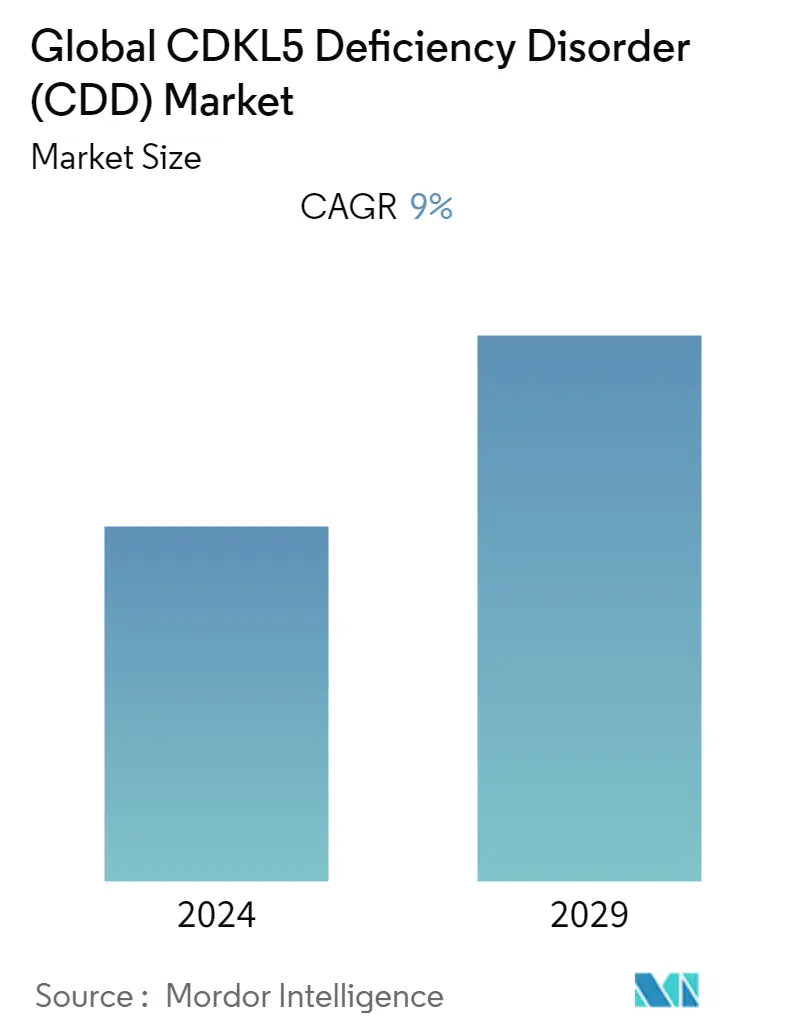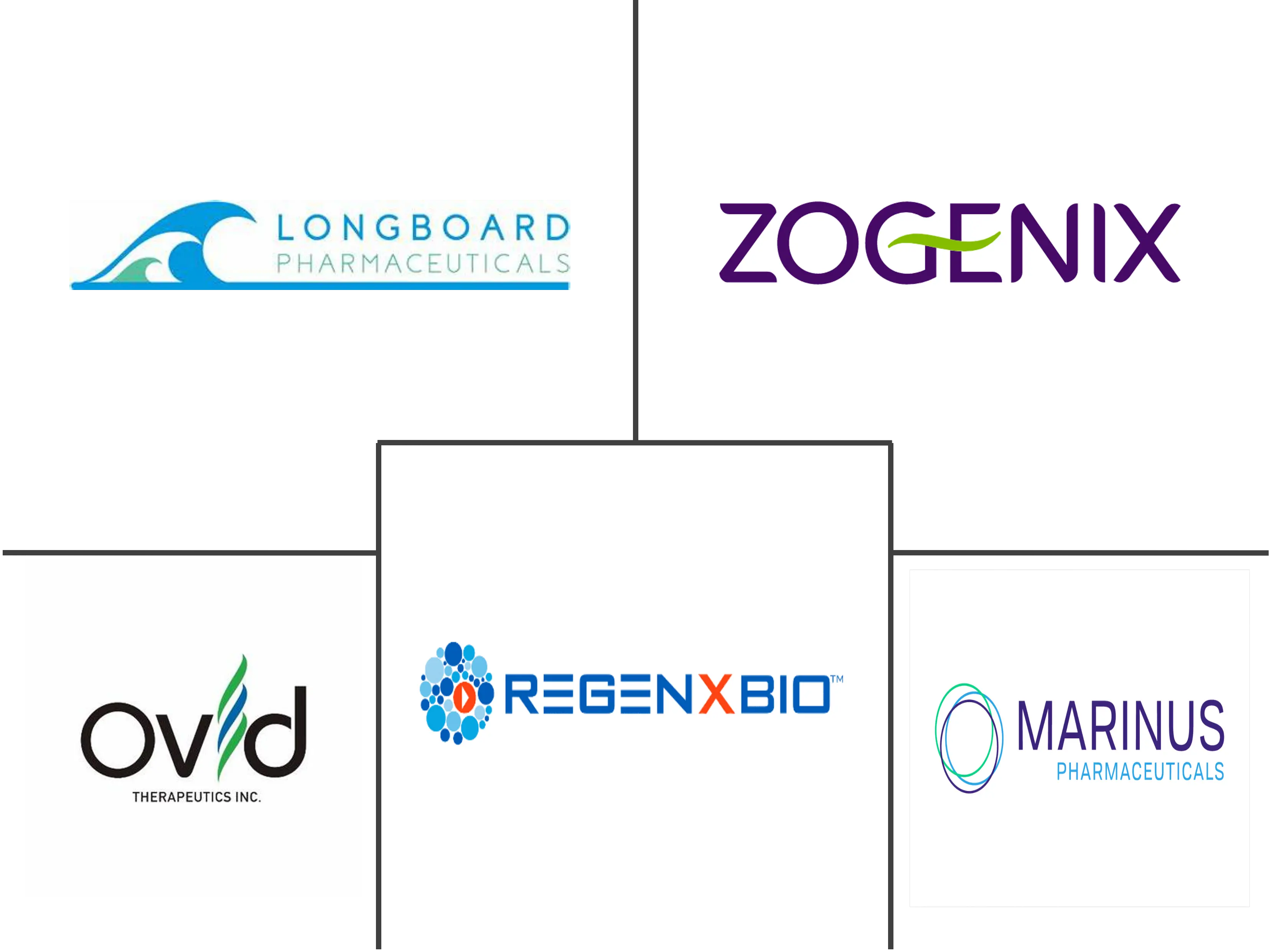Market Size of Global CDKL5 Deficiency Disorder (CDD) Industry

| Study Period | 2019 - 2029 |
| Base Year For Estimation | 2023 |
| Forecast Data Period | 2024 - 2029 |
| CAGR | 9.00 % |
| Fastest Growing Market | Asia-Pacific |
| Largest Market | North America |
Major Players
*Disclaimer: Major Players sorted in no particular order |
Need a report that reflects how COVID-19 has impacted this market and its growth?
Deficiency Disorder Market Analysis
The CDKL5 deficiency disorder market is projected to register a CAGR of 9% during the forecast period (2022 - 2027).
With the increasing COVID-19 cases worldwide, healthcare services diverted all resources toward patients suffering from COVID-19 disease. Although COVID-19 severely affects the respiratory system, it has been reported to show effects on central and peripheral systems. These included encephalopathy, inflammation, ischaemic stroke, and peripheral neurological disorders. An article titled 'Epilepsy and COVID-19: Assumptions and Important Considerations' published in July 2020 stated that the Centers for Disease Control and Prevention (CDC) had suggested that neurological comorbidities, including epilepsy, may be risk factors for COVID-19, despite a lack of evidence. However, this statement was later removed from the Centers for Disease Control and Prevention (CDC) website. According to the article titled 'Epilepsy and COVID-19: Updated Evidence and Narravative Review' published in March 2021, active epilepsy would be an independent risk factor for both the incidence and mortality of COVID-19. In that study, active epilepsy was associated with a 5.1-fold greater odds ratio of mortality risk. Additionally, clinical trials on repurposing the epileptic drug for COVID-19 may have minimal impact on the CNS therapeutics market.
With the introduction of more sophisticated genetic testing, CDKL5 disorder is now being diagnosed in children at a relatively early age. Genetic testing prior, which sequenced the gene, would not necessarily have picked up deletions. Several individuals subsequently diagnosed with CDKL5 disorder were previously given a negative result. Therefore, a child with the phenotype who has previously tested negative, yet does not have a genetic diagnosis, should be re-tested to include deletion and duplication testing of the CDKL5 gene. As per CDKL5 Research Collaborative, there are estimated to be several thousand cases worldwide, but that number frequently changes as improved genetic testing has evolved and population studies are undertaken.
The diagnosis is based on a simple blood test. More recently, some labs have used a buccal swab of the cheek. The blood or saliva swab is then sent to a special laboratory that performs the genetic test. Recently, CDKL5 testing has become widely available in epilepsy and developmental delay genetic panels, thereby allowing testing of multiple potential disease-causing genes all at the same time at a cost similar to just testing the CDKL5 gene alone. Therefore, the improved diagnosis will lead to an increased patient population, and patients will further seek treatment for the disease. In addition, the molecular biology of CDD is revealing opportunities in precision therapy, with phase II and III clinical trials underway or planned to assess disease-specific and disease-modifying treatments.
In the last few decades, CDD research has seen great progress, with more researchers now studying the causes, diagnosis, and treatment of CDD at many medical centers, university hospitals, and other institutions. There has been a dramatic increase in much-needed research, including ongoing clinical investigations for future therapies. Additionally, several organizations, such as the International Foundation for CDKL5 Research, CDKL5 Research Collaborative, CDKL5 alliance, CDKL5 UK, Loulou Foundation (UK), CDKL5 Alliance Francophone, along with several pharmaceutical companies, have been working in a positive direction for better treatment alternatives in the market. For instance, in October 2021, The Loulou Foundation, a private foundation dedicated to the development of therapeutics for the neurodevelopmental condition CDKL5 Deficiency Disorder (CDD), announced today that seven biopharmaceutical industry partners together with the Loulou Foundation had formed a pre-competitive consortium to direct a key clinical study for the development of disease-modifying therapeutics for CDD. The seven companies are Amicus Therapeutics; Biogen Inc.; Elaaj Bio; Marinus Pharmaceuticals Inc.; PTC Therapeutics; Ultragenyx Pharmaceutical Inc.; and Zogenix, Inc. Also, several agents with novel mechanisms of action are keenly being reconnoitered in ongoing clinical trials. Similarly, an initiative from several other countries is providing comprehensive and relevant health information related to various health-related problems, including CDD. Such collective and increasing awareness programs help patients to know about the disease and available safe treatment options, which are expected to drive the market growth of CDD.
